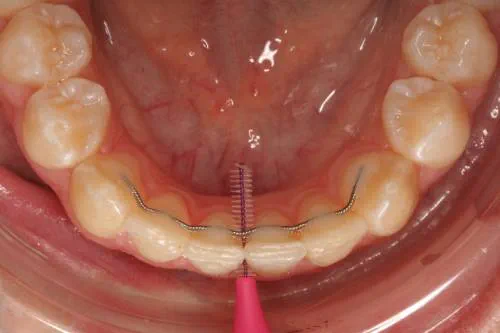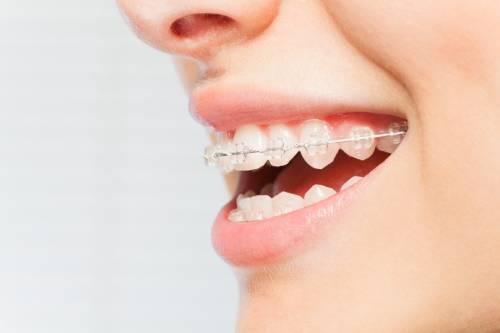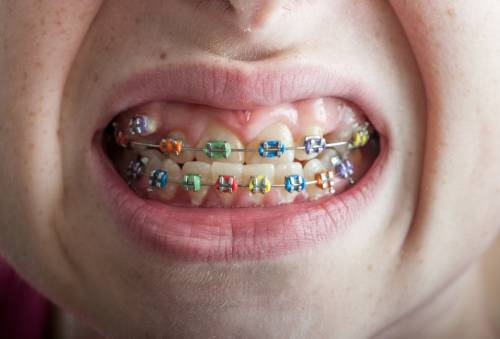Navigation
Maintaining oral hygiene with braces
Whether you have fixed braces, clear aligners for discreet teeth straightening, or no need for orthodontic treatment at all, maintaining good oral hygiene remains important for your dental and overall health and wellbeing. People undergoing orthodontic treatment with braces need to take extra care to uphold a thorough oral health routine, as braces often create more nooks and crannies in which tooth-damaging bacteria can grow.
It might take a little longer and may require a little more work to keep your teeth in tip-top condition when wearing braces. However, if you want your teeth to look and feel at their best when your teeth straightening journey comes to an end, putting in the effort to raise your oral hygiene routine is absolutely essential.

Why is oral hygiene important?
Keeping your oral hygiene in check will help you prevent gum disease, bad breath and tooth decay that can lead to damaged, loose or failing teeth, as well as plenty of discomfort and the need for additional dental treatment and attention.
Failing to brush for at least two minutes twice a day with a fluoride toothpaste will allow the buildup of bacteria which forms into plaque. This damages the tooth enamel and can lead to a range of health problems.
Before any orthodontic treatment begins, your orthodontist will thoroughly check your mouth and gums to ensure your teeth are in a fit state to be straightened. If there are any signs of disease, infection or decay, the process of straightening teeth - which applies consistent pressure to permanently move them in the mouth - can be dangerous, leading to damaged teeth and gums, or issues with the jawbone and supporting structure of the teeth.
As well as this, failure to maintain good oral hygiene while wearing braces can lead to gum disease, decay or infections during the treatment. If this occurs, your orthodontist will have no choice but to stop the treatment early, potentially delaying your new straighter and more confident smile by a considerable length of time.
How do you maintain good oral hygiene when wearing braces?
Your oral hygiene routine when wearing braces isn’t considerably different to what you were doing before - you’ll still need to brush, floss and visit the dentist regularly. You’ll need to use a slightly different technique when flossing or brushing with braces, but it won’t be difficult to get used to.
It’s important to remember that everyone’s teeth straightening journey is different, and if you have any questions or concerns regarding keeping your teeth and gums healthy when wearing braces, your orthodontist will be happy to provide tailored advice.
Here’s what you need to know when it comes to maintaining oral hygiene when wearing braces:
Brushing is essential
Healthy teeth require regular brushing. It’s a non-negotiable aspect of oral hygiene, which should be undertaken at least twice per day, for at least two minutes with a fluoride toothpaste.
When you’re wearing braces, you need to be a little more thorough than usual with your brushing. This is because braces can encourage food particles to get trapped between the brackets and wires, allowing bacteria that can harm your tooth enamel to develop more easily.
It’s recommended for people with braces to brush their teeth after each meal or snack. Use special interdental brushes to brush behind wires and around brackets to dislodge any traces of food.

Can I whiten my teeth with braces?
While using teeth whitening toothpastes or products with braces won’t necessarily cause any harm, it’s generally not recommended by orthodontists or oral health professionals. This is because the teeth whitening products can’t penetrate the brackets fixed to your teeth, meaning any difference to the colour of your teeth will be uneven once the brackets are removed.
You want your new smile to be a confident one, so it’s best to book a professional teeth whitening session after your braces have been removed for the last time. This ensures an even and consistent colour, and provides a finishing flourish for your brand new smile.

Can I floss with braces?
Flossing is always recommended as part of a consistent oral hygiene routine, as it will help you remove particles of food or any buildup of plaque from between the teeth, where brushing sometimes can’t reach.
It’s not always easy to floss with braces, as the brackets and wires can cause regular dental floss to break or get caught. Your orthodontist or dentist may recommend you stick to interdental brushes or other flossing devices in order to keep your teeth and gums healthy, and they can provide a demonstration and answer any questions you might have.

Double check your teeth and braces
Once you’ve completed your brushing and flossing, take a moment to inspect your teeth in the mirror. This is especially important early in your teeth straightening journey, as adjusting to a new way of cleaning your teeth while wearing braces can take some getting used to.
Make sure you haven’t missed any part of your upper or lower teeth with your brushing and flossing, and check the brackets and wires to make sure nothing has moved, become loose or broken.

Tips for avoiding rubbing and sensitivity
It’s normal to feel some discomfort when you first get braces, or when your braces are adjusted after a visit to your orthodontist. However, wearing fixed braces should never be painful.
The most common sources of discomfort for people undergoing teeth straightening treatment are due to the pressure being applied by your braces, which will pass within a week or two and can be relieved with over-the-counter painkillers. Some people find that the brackets and wires rub uncomfortably against parts of their mouth. If this is the cause, use a ball of wax to smooth over the parts of the braces causing the issue. If the issue continues or causes swelling or bleeding, speak to your orthodontist who will be able to help.

Stay away from the snacks
It goes without saying that you should be avoiding sugary snacks - especially chewy sweets and fizzy drinks - when wearing braces, as these can cause tooth decay or other problems with the function of your braces and overall oral health.
Avoiding snacks between meals isn’t always the easiest habit to get used to. As it’s advisable to clean your teeth thoroughly after every meal when wearing braces, it’s something a lot of people having their teeth straightened have to adapt to (and it’s better for your overall health, too). It’s best to stick to healthy foods that don’t require too much crunching or chewing. If you can’t resist the occasional sugary treat, try to enjoy them directly after one of your main meals and before you brush your teeth.

Do I still need to visit the dentist when wearing braces?
A lot of people think that, because you visit the orthodontist regularly when you’re having teeth straightening treatment, you no longer need to stick to your dentist check-up routine.
However, going to the orthodontist isn’t the same as visiting the dentist and dental hygienist. While our specialist orthodontists will be able to spot signs of gum disease or tooth decay, and can provide advice on how to maintain good oral health, your regular general dentist appointments are still important for a more thorough check-up and to spot any early warning signs of oral health issues before they become more serious.
How often should I change my toothbrush?
Excellent oral hygiene requires the right tools for the job. If your toothbrush is looking a bit tired and the bristles are worn, it’s high time to pick up a replacement.
Most dentists would recommend switching up your toothbrush every three months, but people with fixed braces often find that their toothbrushes show signs of wear more quickly. If you opt for an electric toothbrush, you’ll need to replace the head when the bristles are no longer straight to maximise their cleaning potential.Interested to see what teeth straightening treatment can do for you, or want advice on the best type of braces to suit your needs?
Book your free, no-obligation Total Orthodontics consultation today.